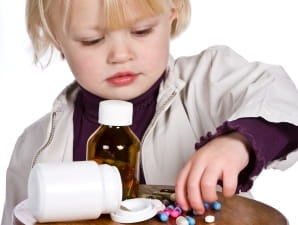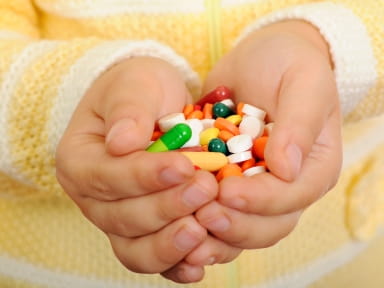Increasing Childhood Drug Poisonings

The Bottom Line
More young children now visit U.S. emergency rooms for drug poisonings than for car crashes. The most dangerous prescription medicines for children to get into include those for diabetes, anxiety, muscle spasms, sleep problems, heart disease, and high blood pressure, and opioid (narcotic) pain relievers.

The Full Story
More young children now visit U.S. emergency rooms for drug poisonings than for car crashes. This is mostly due to an increase in the number of children who find and swallow prescription drugs at home.
The most dangerous prescription medicines for children are:
- pills to treat diabetes;
- opioids (narcotic) pain relievers;
- drugs to treat anxiety, muscle spasms, and sleep problems;
- drugs to treat heart disease and high blood pressure.
Why are dangerous childhood poisonings increasing? More and more adults are taking more and more prescription medicines. This is especially true for opioid pain relievers – drugs like oxycodone, hydromorphone, morphine, methadone, and fentanyl. Older children also are taking more medicines – to treat attention deficit disorders and, increasingly, to treat Type 2 diabetes. If more medicines are present in young children’s homes, there are more chances for them to find and swallow them.
It can be very difficult for parents and caregivers to keep every medicine locked up all the time. Some medicines must be taken frequently. Travel also complicates safe storage. Even the most diligent parent can be interrupted while taking medicines. To help decrease childhood poisoning, researchers propose that medicine packaging limit the amount of drug available at one time. For example, children can’t open many child resistant blister packs at once. Liquid medicines could also be dispensed in containers that permit only one dose at a time to be released.
For now, poison prevention measures are more important than ever:
- Use child-resistant packaging. Replace caps tightly after use.
- Lock all medicines up high, out of sight and reach of children.
- Take medicines when children aren’t looking, because children will imitate adults taking medicines.
- Be sure that all family members and visitors are vigilant about locking up their medicines.
- Take special care when traveling to be sure that medicines are locked away from children.
If you think a child may have swallowed too much medicine or someone else’s medicine, use the webPOISONCONTROL® online tool for guidance or call Poison Control right away at 1-800-222-1222. Do NOT wait to see if the child becomes ill – by then it may be too late to prevent a tragedy.
Rose Ann Gould Soloway, RN, BSN, MSEd, DABAT emerita
Clinical Toxicologist
Poisoned?
Call 1-800-222-1222 or
Prevention Tips
Poison prevention measures are more important than ever:
- Use child-resistant packaging. Replace caps tightly after use.
- Lock all medicines up high, out of sight and reach of children.
- Take medicines when children aren’t looking, because children will imitate adults taking medicines.
- Be sure that all family members and visitors are vigilant about locking up their medicines.
- Take special care when traveling to be sure that medicines are locked away from children.
This Really Happened
Case 1: A 2-year-old girl drank some juice which she said made her tongue feel "weird". Then she took a nap. When she was found, she was limp and cold. Her breathing, heart rate, and blood pressure were extremely low. In the emergency room, a breathing tube was put in. She was given naloxone, a drug to treat narcotic overdoses, because her symptoms were like a narcotic overdose. By the next day, brain damage was confirmed. She was declared brain dead after six days; she died the day after.
It was later learned that the juice had been mixed with methadone, a narcotic drug. Methadone is used as a pain reliever and to treat people with heroin addiction. While it is often mixed with juice, it is never safe to store it where children – or anyone to whom it's not prescribed – can make a mistake with it.
Reference: Bronstein AC, Spyker DA, Cantilena LR Jr. Ruamck BH, Dart RC. 2011 Annual report of the American Association of Poison Control Centers’ National Poison Data System (NPDS): 29th annual report. Clinical Toxicology. 2012;50:911–1164.
Case 2: A 1-year-old boy got into a bottle of clonidine 0.1 mg that had been left out on a dresser. (Clonidine is a drug used to control high blood pressure and also for treatment of attention deficit hyperactive disorder in children.) His mom called 911, who conferenced Poison Control. She reported that the child’s breathing was changing. Poison Control recommended naloxone (a drug that can reverse depressed breathing in narcotic poisoning but may also be useful with clonidine) if the child's breathing rate was low. On arrival to the emergency room he was extremely drowsy and responsive only to stimulation such as shaking him or loud voices. His blood pressure (BP) and heart rate (HR) were low. He had not required naloxone but was placed on intravenous (IV) fluids and oxygen.
The emergency physician consulted Poison Control and was advised to admit the child to the hospital on a cardiac monitor, at least overnight. The little boy was admitted to pediatric intensive care. Four hours after the child got into the clonidine, he remained very sleepy but would cry and fuss when stimulated. He was breathing well off oxygen but remained on IV fluids. His HR remained slightly low for a child his age. Seventeen hours after the clonidine ingestion, the child was lethargic but appropriately upset when touched by his nurses. His BP and HR were normal He was taking oral fluids well and was sent home later that day.
References
Bond GR, Woodward RW, Ho M. The Growing Impact of Pediatric Pharmaceutical Poisoning. J Pediatr. 2012;160:265-70. Accessed Mar 7, 2014.Poisoned?
Call 1-800-222-1222 or
Prevention Tips
Poison prevention measures are more important than ever:
- Use child-resistant packaging. Replace caps tightly after use.
- Lock all medicines up high, out of sight and reach of children.
- Take medicines when children aren’t looking, because children will imitate adults taking medicines.
- Be sure that all family members and visitors are vigilant about locking up their medicines.
- Take special care when traveling to be sure that medicines are locked away from children.
This Really Happened
Case 1: A 2-year-old girl drank some juice which she said made her tongue feel "weird". Then she took a nap. When she was found, she was limp and cold. Her breathing, heart rate, and blood pressure were extremely low. In the emergency room, a breathing tube was put in. She was given naloxone, a drug to treat narcotic overdoses, because her symptoms were like a narcotic overdose. By the next day, brain damage was confirmed. She was declared brain dead after six days; she died the day after.
It was later learned that the juice had been mixed with methadone, a narcotic drug. Methadone is used as a pain reliever and to treat people with heroin addiction. While it is often mixed with juice, it is never safe to store it where children – or anyone to whom it's not prescribed – can make a mistake with it.
Reference: Bronstein AC, Spyker DA, Cantilena LR Jr. Ruamck BH, Dart RC. 2011 Annual report of the American Association of Poison Control Centers’ National Poison Data System (NPDS): 29th annual report. Clinical Toxicology. 2012;50:911–1164.
Case 2: A 1-year-old boy got into a bottle of clonidine 0.1 mg that had been left out on a dresser. (Clonidine is a drug used to control high blood pressure and also for treatment of attention deficit hyperactive disorder in children.) His mom called 911, who conferenced Poison Control. She reported that the child’s breathing was changing. Poison Control recommended naloxone (a drug that can reverse depressed breathing in narcotic poisoning but may also be useful with clonidine) if the child's breathing rate was low. On arrival to the emergency room he was extremely drowsy and responsive only to stimulation such as shaking him or loud voices. His blood pressure (BP) and heart rate (HR) were low. He had not required naloxone but was placed on intravenous (IV) fluids and oxygen.
The emergency physician consulted Poison Control and was advised to admit the child to the hospital on a cardiac monitor, at least overnight. The little boy was admitted to pediatric intensive care. Four hours after the child got into the clonidine, he remained very sleepy but would cry and fuss when stimulated. He was breathing well off oxygen but remained on IV fluids. His HR remained slightly low for a child his age. Seventeen hours after the clonidine ingestion, the child was lethargic but appropriately upset when touched by his nurses. His BP and HR were normal He was taking oral fluids well and was sent home later that day.
